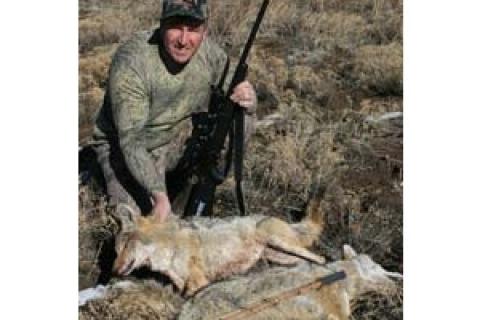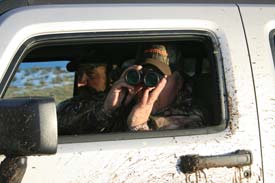
 While coyotes can often be called close to the gun, and having one rush in and meet you face-to-face is as exciting as anything in the hunting world, sometimes crafty coyotes will simply keep their distance. Coyotes that have been hunted become cautious — very cautious — and they normally don't come rushing to calls. When a pressured coyote hears hunter's calling or a possible meal screaming its last dying breaths, the cautious song dog (alias, coyote) will probably sit tight and observe from a long distance before committing to any action. This is often the case in winter when coyotes compete for territory and food supplies.
While coyotes can often be called close to the gun, and having one rush in and meet you face-to-face is as exciting as anything in the hunting world, sometimes crafty coyotes will simply keep their distance. Coyotes that have been hunted become cautious — very cautious — and they normally don't come rushing to calls. When a pressured coyote hears hunter's calling or a possible meal screaming its last dying breaths, the cautious song dog (alias, coyote) will probably sit tight and observe from a long distance before committing to any action. This is often the case in winter when coyotes compete for territory and food supplies.
And the coyote has good reason to sit, observe and keep its distance. During winter, a coyote can see further across the barren landscape, plus any snow makes observation much easier, and hunters in search of fur are easy to spot as they move. Coyotes have an advantage also by being smaller and lower to the ground, and they can peer under most brush. They'll see you walking, or when you pull up your face mask, if you are not careful. One mistake on your part as that hunter means it's time to also move on to another site. It's survival of the fittest — or smartest.
So, before you go running-and-gunning for coyotes, maybe it's time to plan a new long-range hunting strategy. Instead of the close in-your-face shots, expect to reach out 200 yards or beyond with a precision rifle topped with a high-magnification riflescope. You can probably forget your standard .06 rifle and 3x9 deer hunting rifle for this chore.
And while calling might sometimes still make a coyote reveal itself, you might have more success in fur collecting if your plans include stop, study and stalk. Take it from the coyote's play book. You'll need to observe your hunting area from afar, study the winds, and be steady for the shot that follows. Long-range coyote hunting can yield success, and the same features that work for a coyote's advantage can also work for your success.
Priority Number One
 |
| When you stop to glass, stay back in the shadows to help prevent a coyote spotting you. |
Your foremost priority is finding a coyote, especially before it spots you. Plan to do a lot of scouting and cover a lot of territory when playing the long-range game. As you hike backcountry trails or drive rural roads, be on the lookout for scat and coyote tracks in the snow and mud. Coyotes simply move less during cold winter periods to save energy. And look for ravens around deer gut piles and check these closely for signs of recent coyote activity. Also, mark this spot on a map because if it is not red hot with coyote activity now, it probably will be soon. In farm country, check to see if hog lots and cattle feed facilities are discarding animal carcasses away from their operations. As opportunistic diners, coyotes will eat cattle dung, discarded hogs at pig farms, and chicken and turkey carcasses. Be certain to search around stockyards, barn and poultry houses when you hunt on active farms. Don't plan to shoot around these buildings, but do get an idea where the coyotes are coming from by studying their tracks. Did I mention that coyotes in winter also seem hungrier?
Keep an eye also on weather forecasts. Coyotes will be out all day — much like hungry deer — on days when a big storm front is approaching the region you'll hunt. You'll need to be out before the snow or rain drops if at all possible.
When coyotes quit coming to calls, a good rule of thumb is to call much less and scout more often. With a window mount for a spotting scope, you can do a lot of long-range glassing from the comfort of your truck cab. When there's snow on the ground, game trails are also more readily visible. And if that trail crosses your path, take a closer look before you take a step afield on the hunt. Always get out and scout after a fresh snow fall.
There are also other eyes and ears that can help you make important discoveries. Work with local landowners, neighbors, and ranchers when possible. They'll normally be glad to tell you where they've spotted a song dog in recent days or times. Farmers can also tell you when they hear coyotes howling on their property or in their region.
Going the Distance
 |
| If you must call, consider the electronic options. |
Long range shooting is a challenge for many hunters and even more so when temperatures are cold and bodies are covered with bundles of clothing. In preparation, you might make a quick trip to your local gun range, or set up a bench or your shooting sticks and do some pre-hunt practice. Look for opportunities and ranges where you can shoot 200 yards or more. If you'll be shooting with glove covered hands, then practice with glove covered hands. Familiarization will help greatly with the longer shooting challenges you face.
You'll also need a rifle that you can shoot well, and an upper-tier riflescope to help with precision bullet placement. Select bullets that will travel through stronger winter winds, and consider moving from .223 up to .243. Win., .25-06, or .257 Roberts. Look for varmint rifles from the top manufacturers, but forget bull barrels because you'll probably be walking more and moving longer distances on your hunts. If any rifle selected is not creating very tight, near 1-inch groups at 100 yards, consider upgrades like a better stock and crisper trigger. Bell & Carlson, Fajen, Ram Line stocks and Timney Triggers are sources that come to mind that make after-market upgrades for nearly any available rifle. You can also visit a gunsmith to look for custom work that will make your rifle a precision machine at long ranges. And remember to carry and use shooting sticks or the increasingly popular tripods to rest your rifle on.
Note also that single-shot and bolt-action rifles tend to be the most accurate. If you are going to use an AR platform rifle, you'll need match grade barrels and upgrade components to be accurate beyond 200 yards. Any rifle used should be clean — especially the bore — and well lubricated.
Another tactic for long-range shooting success is to use a rangefinder to ensure precision accuracy. Unlike deer and other favored big game species, you don't have inches of grace when placing a shot. Coyotes are small (smaller than the standard house dog) and you'll need to shoot for the center of mass when possible because there's a lot of fur surrounding the song dog that is not backed by muscle mass. Another problem some hunters encounter is becoming very excited about seeing a coyote, then thinking it looks huge against a white or light background. As a rule, dark color objects appear larger against a light background, and a coyote often appears to be wolf size when viewed against snow. Don't fall for this optical illusion.
One last item to help with your long range hunt is a wind gauge. Simple and affordable devices like Brunton's Sherpa and Kestrel's Wind Gauge will help you make a better guess on how much affect the wind will have on your traveling bullet. Winter winds can be brisk and become an important player in the long-range game.
Death is in the Details
 |
| Glassing from your vehicle permits covering more ground, and is less noticeable to coyotes. |
To bag a coyote at long distances during winter months often means more attention to the little things. As you glass, for example, be alert for some odd spot in a snow bank or along a fence row. Look closely and you could discover the tip of a coyote's ear or top of its head. Coyotes like to conserve energy and will drop into snow banks along fence rows and farm fields where they are out in the sun for warmth, but down and out of the wind. And a fence row is the perfect place for them to be in case an unsuspecting pheasant comes running along.
If you do want to call, you'll discover that it's harder to call with mouth blown calls on extremely frigid days because reeds often freeze in place. Do consider switching to an electronic calling system, and pack spare batteries for it.
Finally, you'll want to blend in with the proper camouflage. Some camouflage patterns are predominately green or dark colors. When hunting during the winter months, most backgrounds can be white, dark drab gray or very light tan. If there's snow on the ground, cover yourself and your gear with white or light based camouflage patterns. You'll want to blend in when you set out to hunt and make the shot. If you live in a region that's blanketed with snow, you may consider snow shoes to help you move on the hunt. You should also wear the proper footwear for colder temperatures, but that also permits comfort when walking.
And remember to pack handwarmers to keep fingers nimble and ready to operate gear — like the trigger!
- 4653 views

